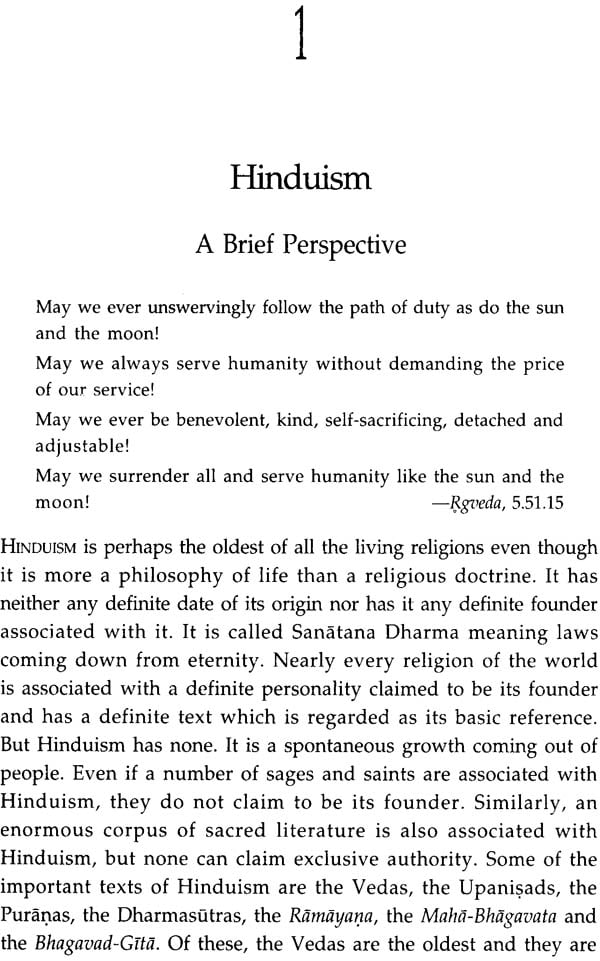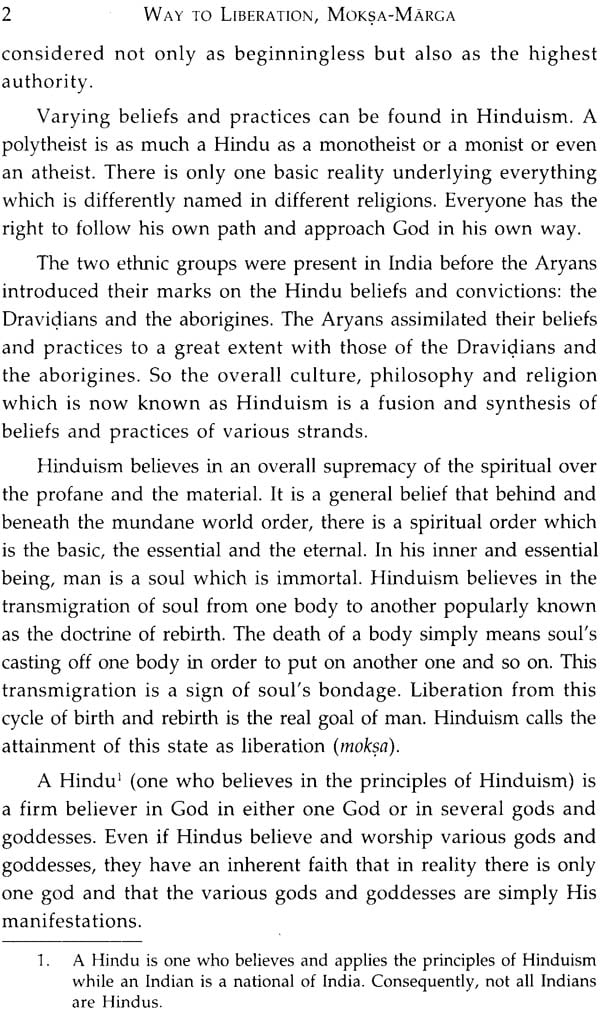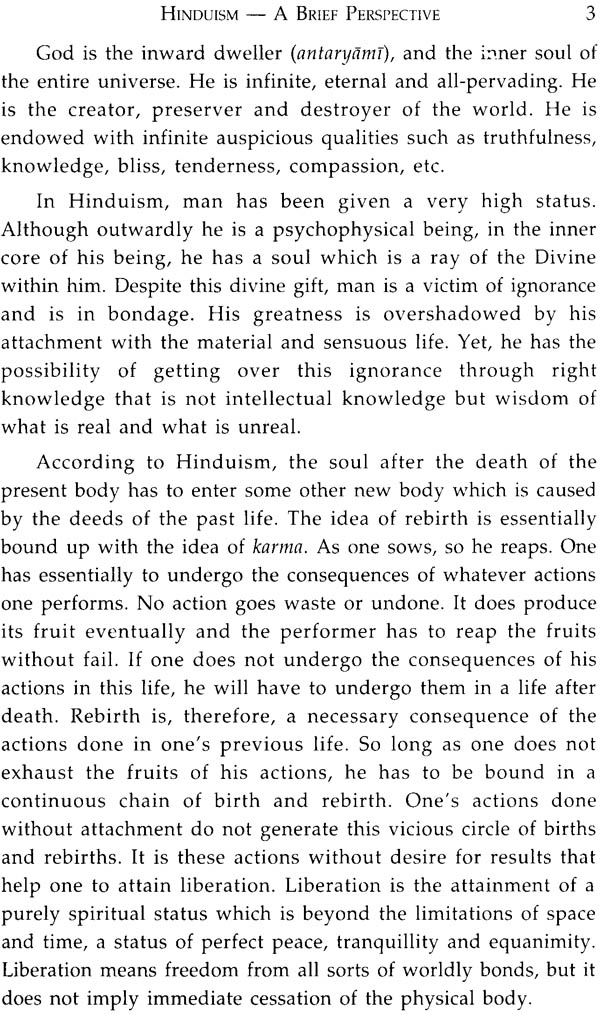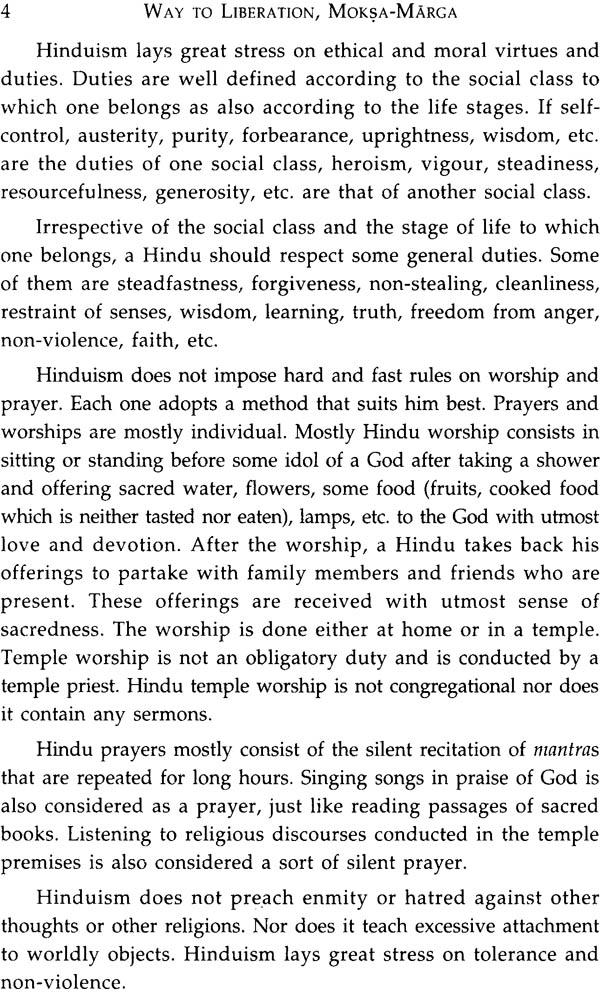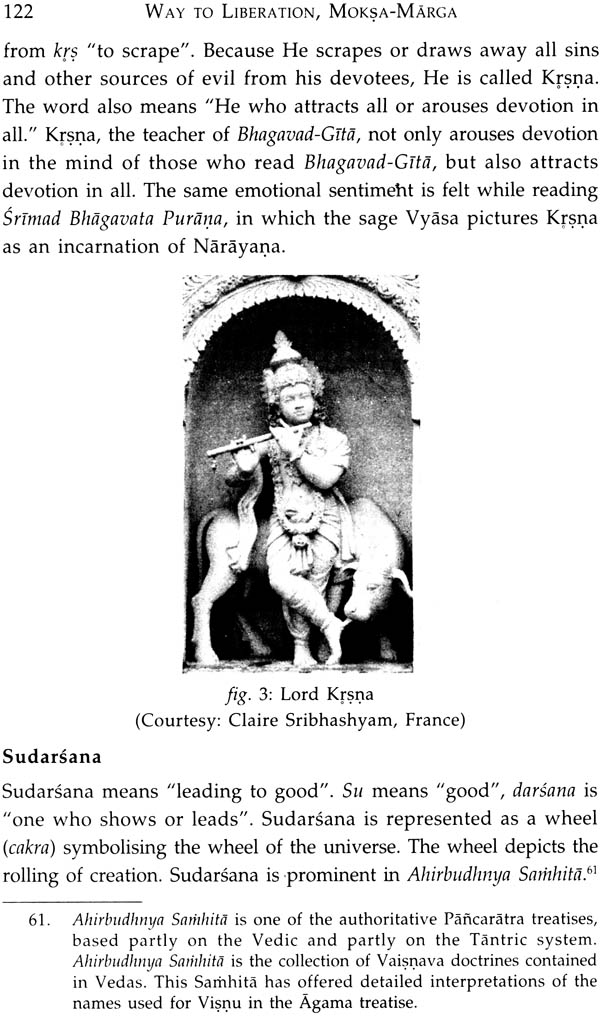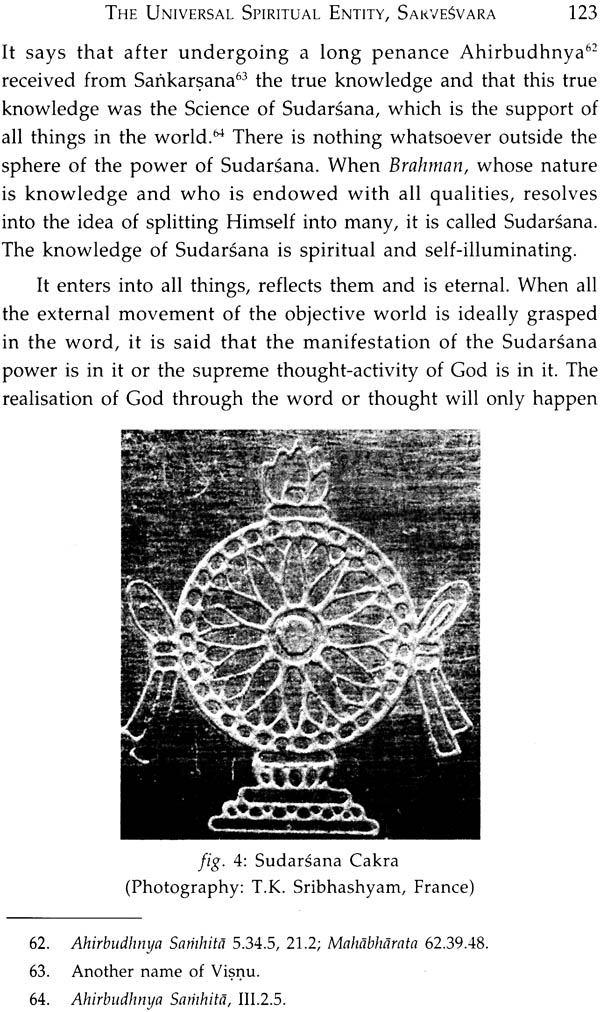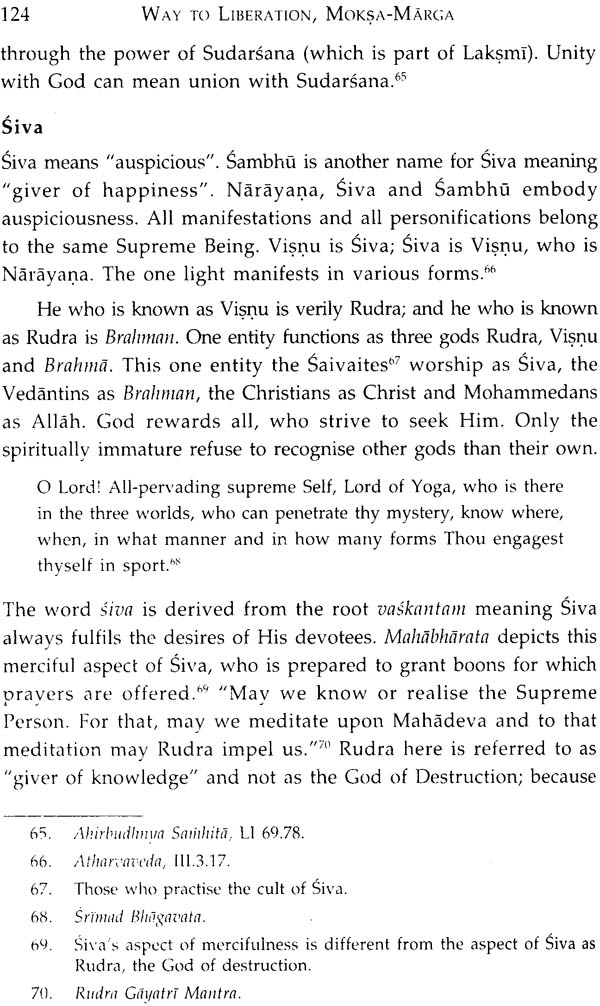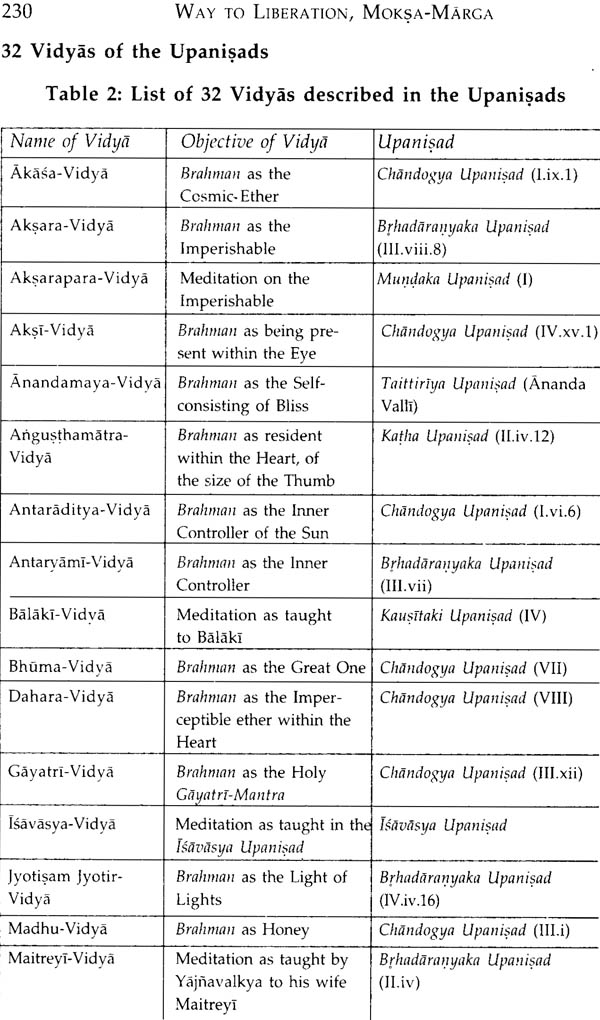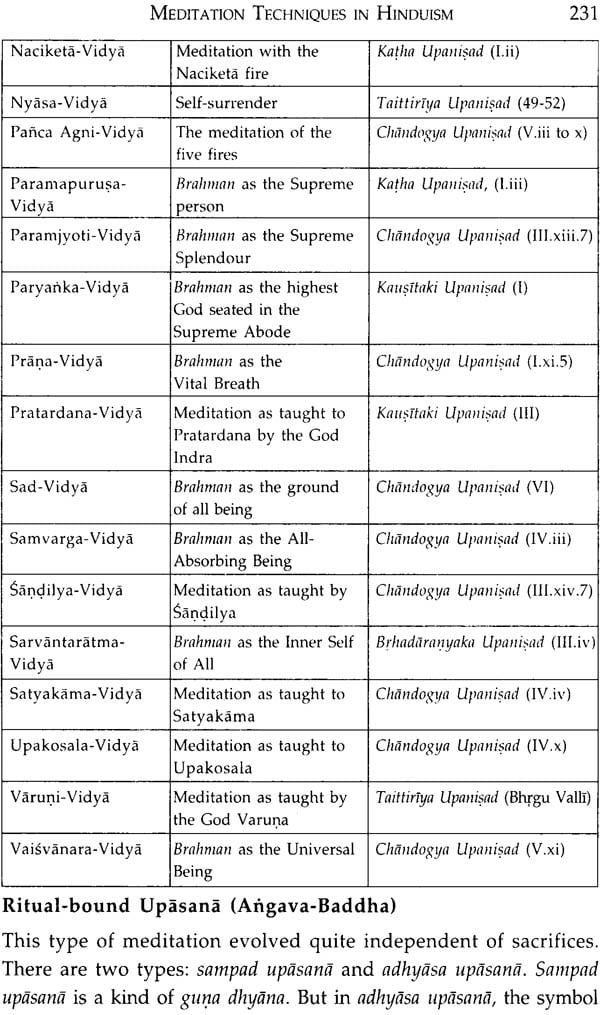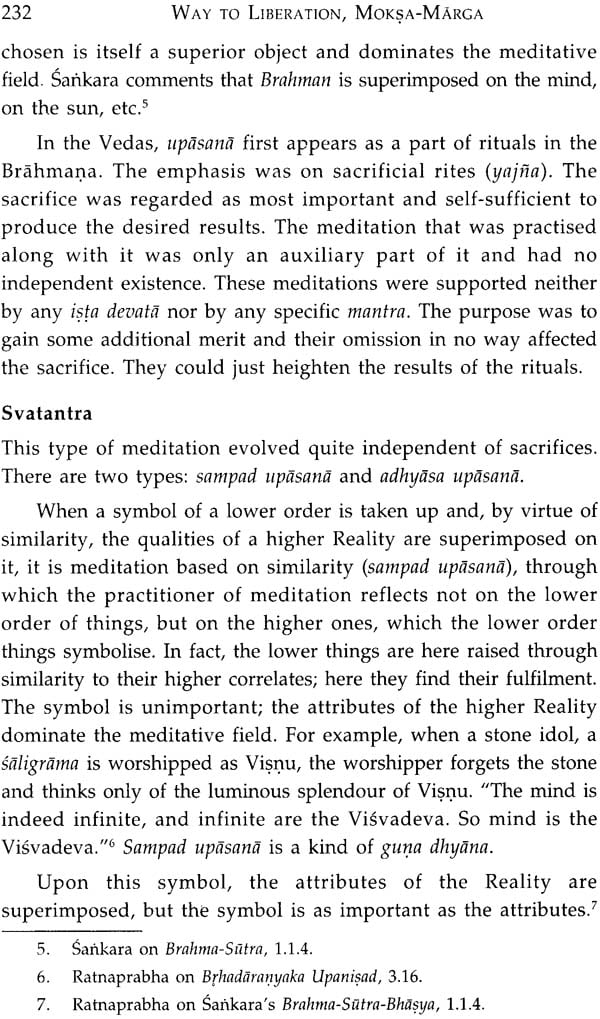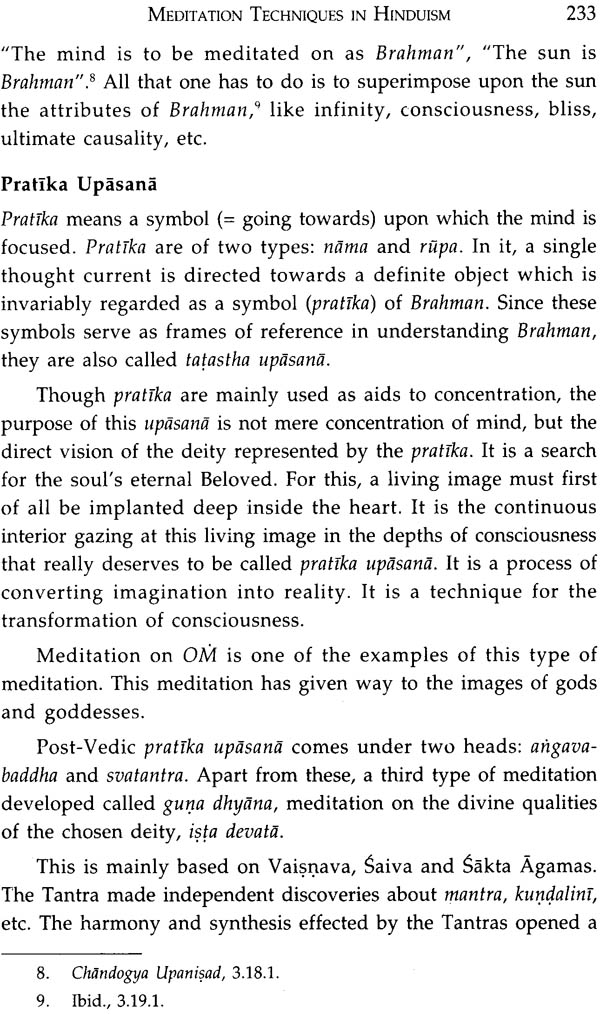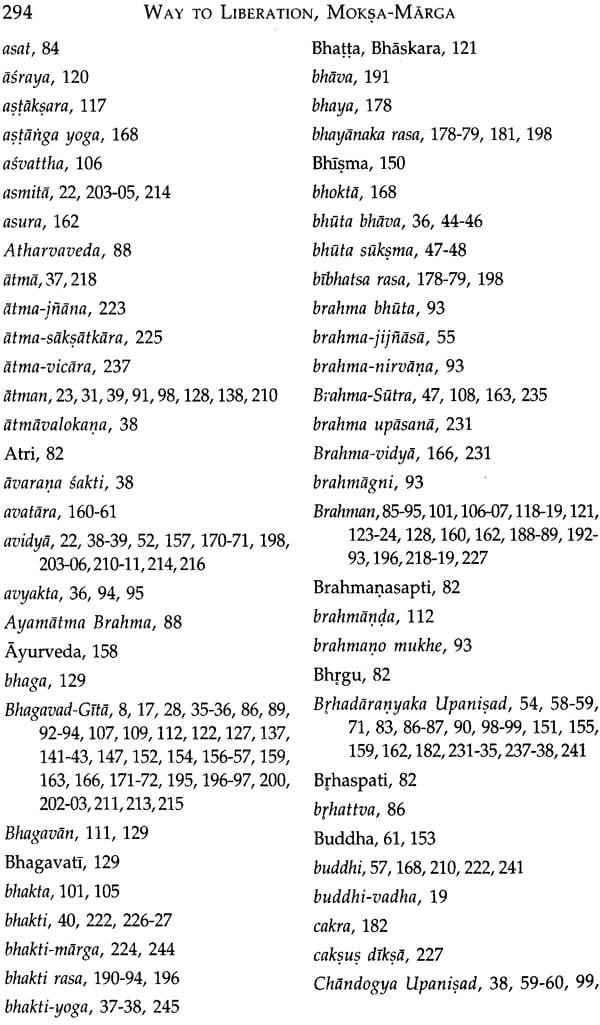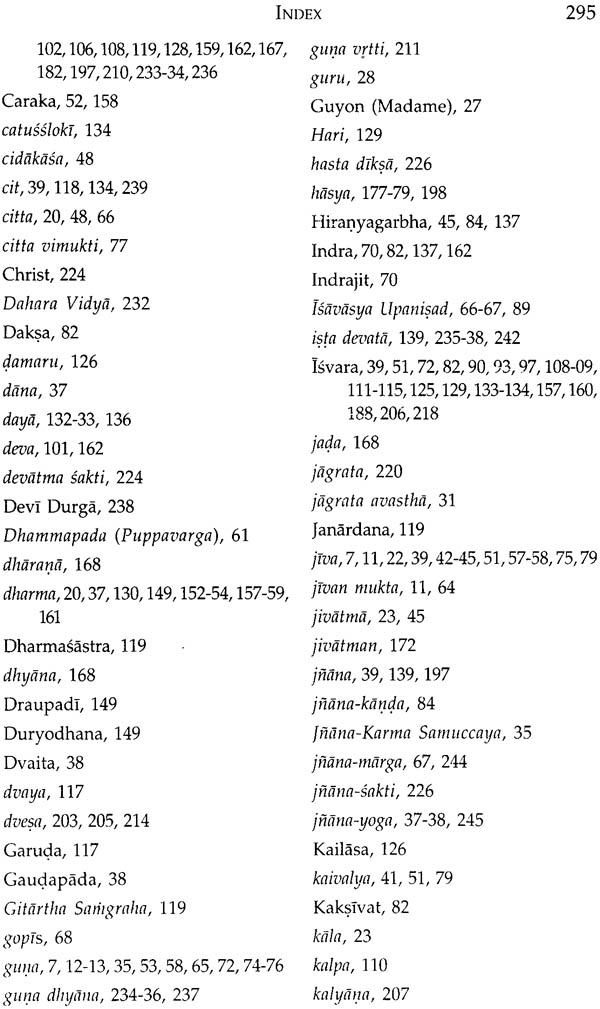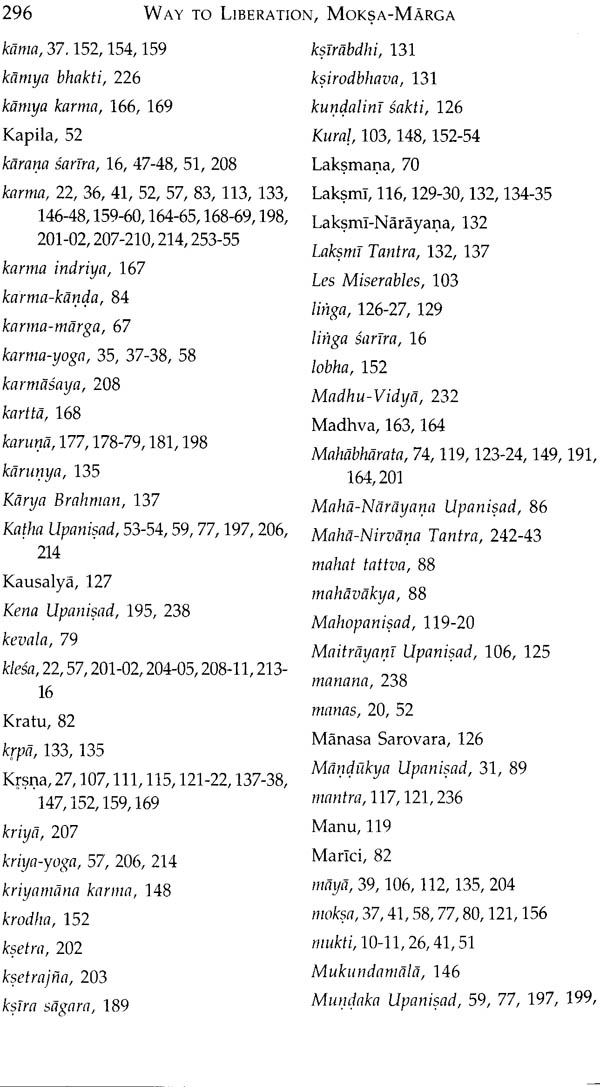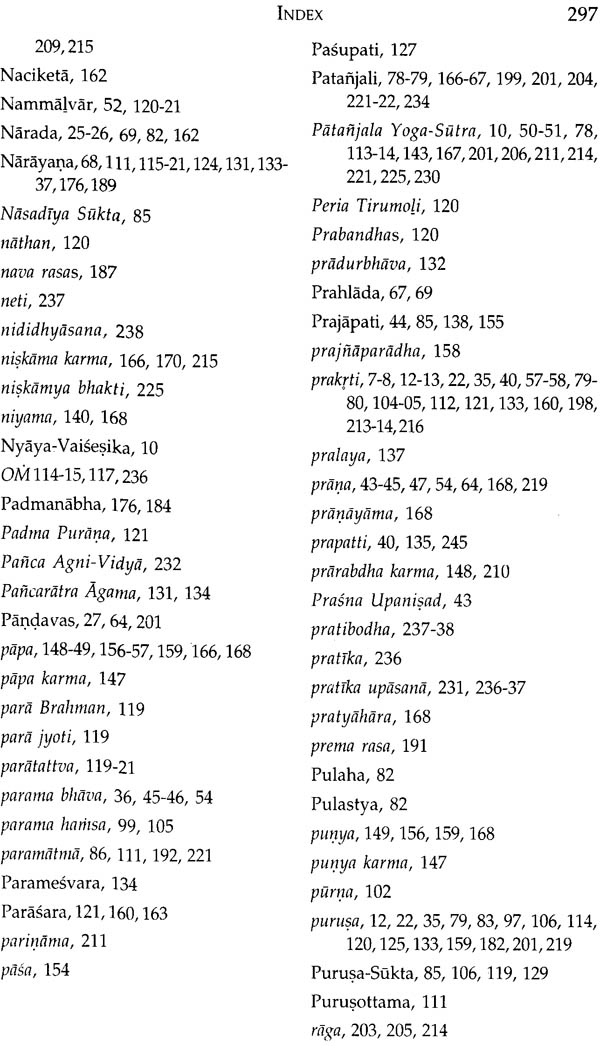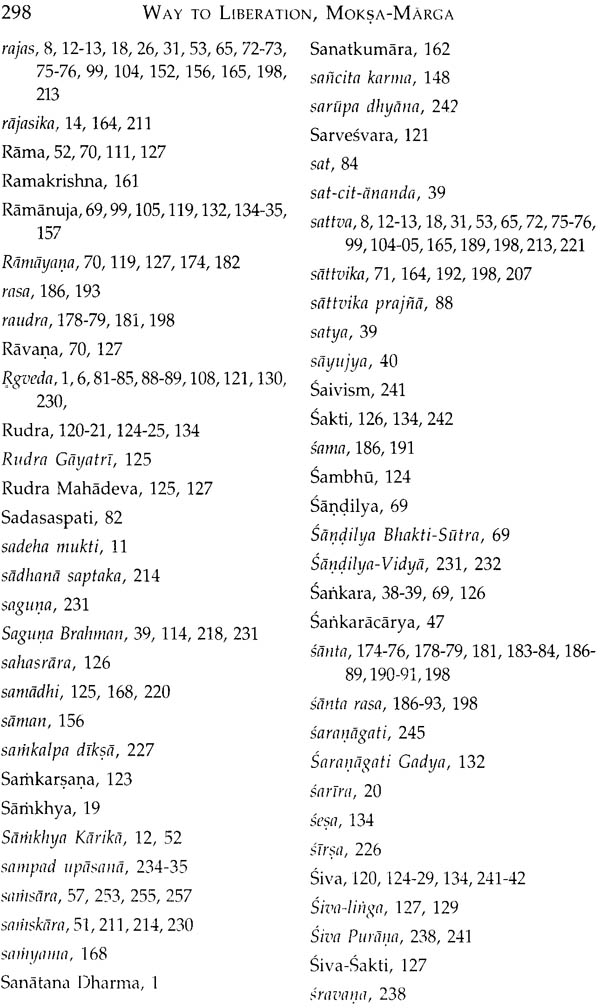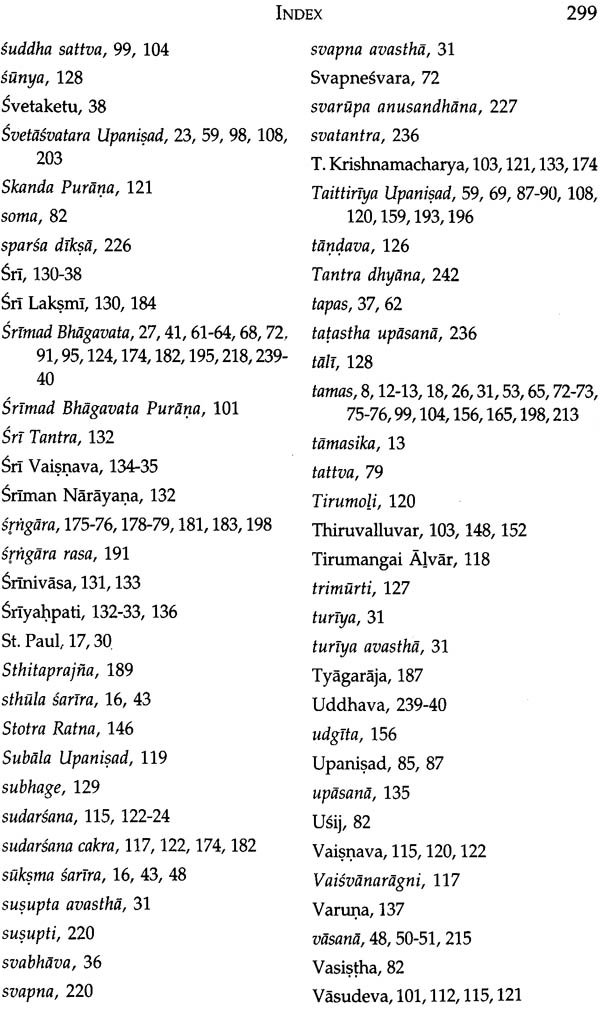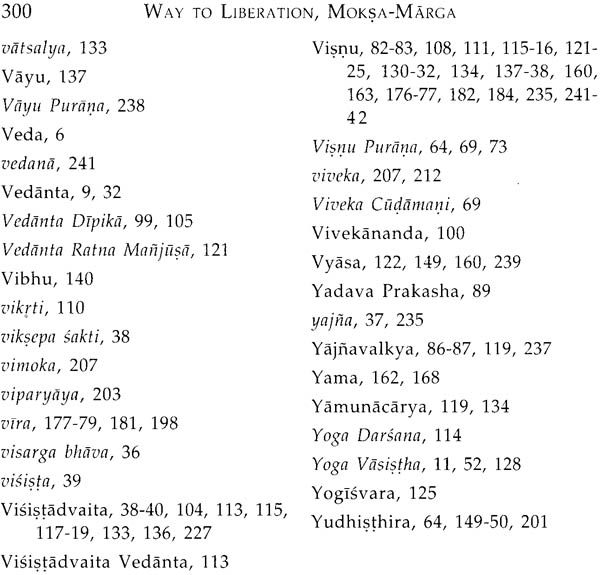
Moksa Marga: Way To Liberation, An Itinerary in Indian Philosophy
Book Specification
| Item Code: | NAC814 |
| Author: | T.K.Sribhashyam &Alamelu Sheshadri |
| Publisher: | D. K. Printworld Pvt. Ltd. |
| Language: | English |
| Edition: | 2011 |
| ISBN: | 8124605998 |
| Pages: | 322 |
| Cover: | Hardcover |
| Other Details | 9.0 Inch X 6.0 Inch |
| Weight | 570 gm |
Book Description
Mind is like the wandering moon. There are always fluctuations in the emotional conditions. This is natural in all living beings. However, man is capable of stabilizing his emotional agitations by personal efforts through various methods. The easiest and successful way is to make sincere appeal to God with love. This type of emotional loving approach to God is bhakti (devotion). Bhakti is supreme love to God. Love springs from God and enters into the human heart. The abundant treasure of God’s love is hidden in the human heart. That is to say, the human heart is overflowing with God’s love. Man has only to realize this wealth of God’s love in him and feel its richness. God shelters man from the scorching miseries of life, when man clings to God. Loving shelter from God is the reward of bhakti practice.
Showering a brilliant light amid gloomy darkness, radiating the sweet fragrance of life, bringing reconciliation to all contradictions are (some of) the gifts of bhakti, in spite of innumerable contradicting views. Bhakti is the golden bridge which links man on earth to the divine paradise. To train the mind for divinity, there is no road equal to devotion, bhakti. Words fail to bring out the pleasure of devotional practices (bhakti sadhana).
THOUGH man acquires and enjoys the material life to his satisfaction, he still feels dissatisfied and he fails to understand the reason. This is because he is in need of peace and real happiness. He takes this as a major suffering in his life. Man suffers, because he identifies his soul with the conglomeration of body and mind. He wants a sort of freedom that he is unable to explain for himself. This state of freedom so badly needed, freedom from suffering and freedom from the sensation of bondage is liberation (moksa). It is obtained when this identification ceases and consciousness too ceases with it. Through devotion, the hook that binds the soul to the created world (prakrti) with its modes is released and the bondage does not reappear. Man finds his ultimate joy through this liberation.
Maksa is the direct path to perfection. It leads to the very heart of the Self-consciousness. It is the final approach to the purity and the perfection of the soul. Happiness is the universal aim of life. True happiness of human beings does not lie in the possession of external things, but in the attainment of the higher mind and spirit, that is to say, in the development of what is the innermost part in us. It may mean pain and restraint, but it will lead us to joy and freedom.
Our mind has a tremendous power. Every individual mind is the master of its destiny and the maker of its body and circumstances. It is the mind that gives us our desired objects. It can create its own body; it can change the form of the body by its own intense and repeated imagination. It can create physical disorders and its own disorder too. In other words, whatever the mind determines to experience, no other agency can withstand. Bondage and freedom are states of mind too and are determined by it. Bondage is due to our wrong belief that we are finite beings. Freedom from ignorance, wrong knowledge and the firm conviction of being one with the Absolute Reality constitute moka. Realizing the absolute is to know the truth and live accordingly. Our knowledge of the truth should go beyond a mere belief; it should become a living experience.
The subject is vast and every effort will be made to clarify the points to enable the reader to feel at ease and to suit the present- day life. All the presentations in the write-ups are taken from the great teachers of the past, who served the individuals as torchbearers to achieve the goal of spiritual realization. We owe all our knowledge to these souls of the past, who invested much effort in making man reach his higher planes of consciousness, thereby helping him to develop his soul together with physical developments in the process of evolution of his life. We owe our gratitude to our father and guru who repeatedly quoted them in all his “classes” as he used to call his lessons.
The lotus-plan of wisdom that has seen the sun of Consciousness and is bearing the blossoms of virtue blooms with a pure and superior lustre, beautiful like the sky at dawn.
The way to liberation or moksa needs perfect knowledge, perfect action and perfect surrender to the Lord. The bhakta becomes a bhagavata as he not only knows and sees but also lives as a servant of God. Moksa is the final approach to the purity and perfection of the human soul. This volume attempts an in-depth study of the concept of liberation or moksa and the way to attain it.
The book begins with the meaning of love, devotion, religion, the body-soul relation and the three yogas, an understanding of which is essential to understand the concept of moksa. In this context, it delves into the meaning of the Brahinan, the Absolute, as conveyed in the Vedas and other religious works like the Upaniads and the Bhagavad-Gita, the concept of the universal spiritual entity of Sarvevara, concepts of sin and virtue, and even the principles of monotheism and polytheism in Hinduism, Quoting from the scriptures and other relevant texts, it emphasises on the notion of devotion and its benefits to examine the means to self-realization and liberation and includes a study of the concept• of contemplation and meditation, including meditation techniques and practices, which is central to the attainment of moksa.
With interesting illustrations, the volume will be useful to religious scholars and students and seekers on the path of spiritual fulfillment.
Mr. T.K. Sribhashyam, son of Shri T. Krishnamacharya, obtained his Master’s degree in accountancy as well as in Hindu philosophy. He also received intensive lessons on yoga philosophy, and Indian psychology. He is the Head of all Yogakshemam schools in Europe. Two of his books in English viz. Blissful Experience, Bhakti — - Quintessence of Indian Philosophy and From Devotion to Total Surrender, Shanagati Yoga —In the Light of Indian Philosophy are appearing from India in 2012. He has published many articles in different yoga journals in Europe. He is an honorary life member of the international Yoga Federation and the world Yoga Council
Mrs. Alanielu Sheshadri, second daughter of Shri T’. Krishnamacharya is graduated from Mysore University. Shri T. Krishnamacharya initiated her to Yajurveda, taught her all major Upanishads, Brahmasutras and the Bhagavad-Gita in traditional way He also trained her in yoga, both practically and philosophically. From 1985 until 1989 she continued studying many philosophical subjects, especially Visistadvaita.
| Genealogy | ix | |
| Benediction by Sri B.K.S Iyengar | xi | |
| Preface | xiii | |
| Presentation | xv | |
| List ofTables and Figures | xvii | |
| 1. | Hinduism -A Brief Perspective | 1 |
| 2. | Introduction | 5 |
| What is Love for Man | 5 | |
| What Love That can Never be Measured | 9 | |
| The Impermanency | 11 | |
| Two Ultimate Aims in Man | 14 | |
| Body- Soul Relation | 19 | |
| Attachment to and Detachment from the Body | 21 | |
| What is Devotion? | 24 | |
| What is Religion? | 28 | |
| The Cultivation of Devotion Withot Religion | 32 | |
| The Three Yogas | 37 | |
| 3. | Concept of Liberation (Moksa) | 41 |
| Views on Soul and Liberation | 51 | |
| Means to Liberationr | 55 | |
| Karma and Liberation | 56 | |
| Liberation as the Aim of Devotion | 57 | |
| Devotion and Libertion | 63 | |
| Liberation: Yoga and Samkhya View | 77 | |
| 4. | Brahman,The Absolute | 81 |
| Brahman in the Vedas | 84 | |
| Brahman in the Upanisads | 85 | |
| Brahman in Bhagavad-Gita | 91 | |
| Brahman the Unmanifest | 94 | |
| 5. | The Universal Spirtual Entity, Sarvesvara | 95 |
| Concept of the Universal Spiritual Entity | 96 | |
| Attributes of the Universal Spiritual Entity, God | 106 | |
| One Without a Second | 107 | |
| Formless | 108 | |
| Incarnation | 108 | |
| Omniscient | 109 | |
| Omniscient | 109 | |
| Non-intrusive | 110 | |
| Just and Benevolent | 110 | |
| Monotheism and Polytheism | 110 | |
| Narayana | 114 | |
| Visnu | 121 | |
| Krsna | 121 | |
| Sudarsana | 123 | |
| Siva | 124 | |
| Sri as Goddess | 129 | |
| Concept of Hiranyagarbha (the Golden Egg) | 137 | |
| Jesus as God, Guru and Saints | 137 | |
| Conception of a religion-free God | 138 | |
| 6. | Concept of Sin and Virtue | 145 |
| Concept of Karma | 145 | |
| Concept of Sin | 148 | |
| The Universal Spiritual Entity is not the Judge of Our Sin | 157 | |
| Role of Sin and Vice | 164 | |
| Jiva and Karma | 167 | |
| 7. | Peaceful Emotion, Santa Rasa | 172 |
| Birth of Human Emotions | 172 | |
| Peaceful Emotion, Santa Rasa | 184 | |
| Santa Rasa and Bhakti | 187 | |
| 8. | Benefits of Devotion | 193 |
| Introduction | 193 | |
| Devotion Reduces the Consequences of the Activities of other Emotions | 195 | |
| Realisation Reduces the Consequences of Klesa and Karma | 199 | |
| Avidya | 202 | |
| Asmita | 202 | |
| Raga | 203 | |
| Dvesa | 203 | |
| Abhinivesa | 203 | |
| 9. | Devotion as a Means | 215 |
| To Self-Realisation, Atma-Jnana | ||
| Brahman and Our Consciousness | 216 | |
| Self-realisation | 218 | |
| 10. | Meditation Techniques inHinduism | 227 |
| Upasana, Vidya | 228 | |
| Brahma Upasana or Brahma- vidya | 228 | |
| Vidya | 228 | |
| 32Vidyas of the Upanisads | 230 | |
| Ritual bound Upasana (Angava Baddha) | 231 | |
| Svatantra | 232 | |
| Pratika Upasana | 233 | |
| Subjective Meditation Techniques | 234 | |
| Meditation in the Puranas | 235 | |
| Meditation in Vaisnavism | 237 | |
| Meditation in Saivism | 238 | |
| Meditation in Tantra, Tantradhyana | 239 | |
| 11. | Practical Exercises in Contemplation and Meditation | 241 |
| Five steps to meditation | 245 | |
| Preparatory Practices | 245 | |
| Contemplation | 245 | |
| Maditation | 246 | |
| Dedication | 246 | |
| Practice | 246 | |
| Preparatory Practices | 247 | |
| Contemplation | 249 | |
| Confidence in a Spiritual Teacher | 249 | |
| Precious Human Life | 250 | |
| Death Consciousness | 250 | |
| The Risk of a Downgraded Life | 251 | |
| Karma and Its Effects | 252 | |
| Developing Renunciation | 252 | |
| Developing Equanimity | 254 | |
| Recognising the Kindness of all Beings | 255 | |
| Cherishing Other Equally | 256 | |
| Compassion | 257 | |
| Meditation | 257 | |
| Peaceful Mind | 257 | |
| Vision of the Self | 258 | |
| Renunciation of the l-ness | 259 | |
| Refuting the Premanence of the Body | 261 | |
| Viion of the Ultimate | 262 | |
| Dedication of Meditation | 262 | |
| Glossary | 265 | |
| Bibliography | 286 | |
| Index | 293 |
